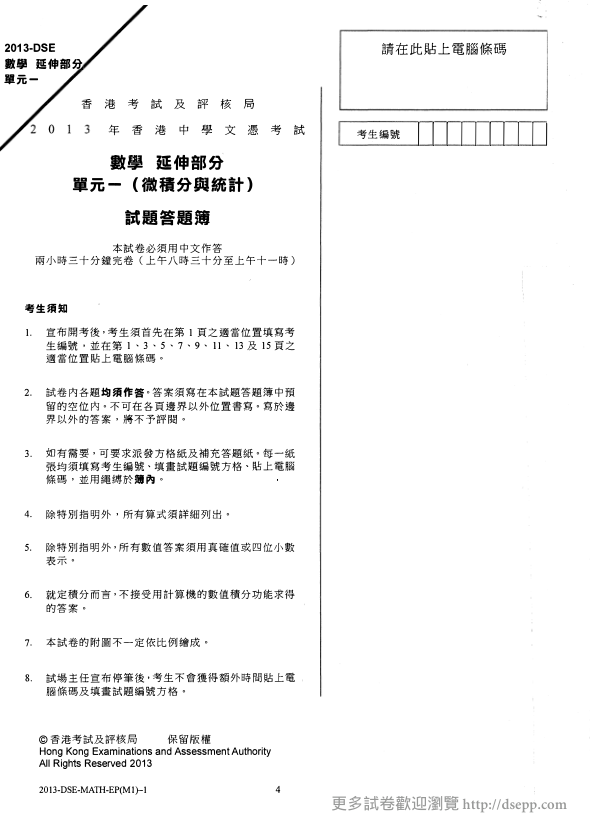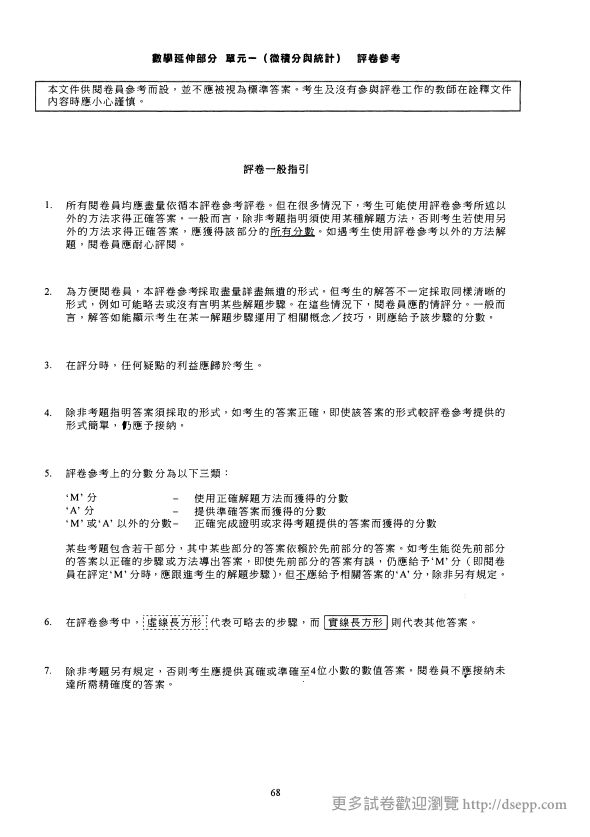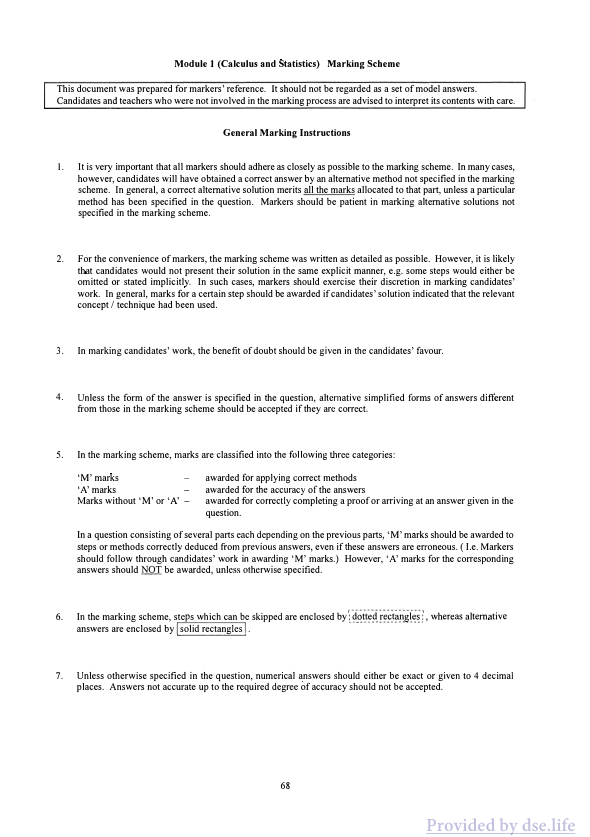2013 DSE 数学延伸部分-M1 真题 答案 详解
| 序号 | 文件列表 | 说明 | ||
|---|---|---|---|---|
| 1 | 2013-数学延伸部分-M1-paper-eng.pdf | 32 页 | 9.06MB | 真题(英文) |
| 2 | 2013-数学延伸部分-M1-paper-zh.pdf | 32 页 | 8.93MB | 真题(中文) |
| 3 | 2013-数学延伸部分-M1-answer-zh.pdf | 10 页 | 1.08MB | 答案(中文) |
| 4 | 2013-数学延伸部分-M1-answer-eng.pdf | 10 页 | 1.48MB | 答案(英文) |
真题(英文)
2013-DSE MATH EP M1
HONG KONG EXAMINATIONS AND ASSESSMENT AUTHORITY HONG KONG DIPLOMA OF SECONDARY EDUCATION EXAMINATION 2013
MATHEMATICS Extended Part Module 1 (Calculus and Statistics)
Question-Answer Book
8:30 am – 11:00 am (2½ hours) This paper must be answered in English
INSTRUCTIONS 1. After the announcement of the start of the examination, you should first write your Candidate Number in the space provided on Page 1 and stick barcode labels in the spaces provided on Pages 1, 3, 5, 7, 9, 11, 13 and 15. 2. Answer ALL questions in this paper. Write your answers in the spaces provided in this Question-Answer Book. Do not write in the margins. Answers written in the margins will not be marked. 3. Graph paper and supplementary answer sheets will be supplied on request. Write your Candidate Number, mark the question number box and stick a barcode label on each sheet, and fasten them with string INSIDE this Book. 4. Unless otherwise specified, all working must be clearly shown. 5. Unless otherwise specified, numerical answers should be either exact or given to 4 decimal places. 6. For definite integrals, answers obtained by using numerical integration functions in calculators are not accepted. 7. The diagrams in this paper are not necessarily drawn to scale. 8. No extra time will be given to candidates for sticking on the barcode labels or filling in the question number boxes after the ‘Time is up’ announcement.
© Hong Kong Examinations and Assessment Authority All Rights Reserved 2013
2013-DSE-MATH-EP(M1)-1
Provided by dse.life

真题(中文)
2013-DSE 數學 延伸部分 單元一
香港考試及評核局 2013年香港中學文憑考試 數學延伸部分 單元一(微積分與統計) 試題答題簿
本試卷必須用中文作答 兩小時三十分鐘完卷(上午八時三十分至上午十一時)
考生须知 1. 宣布開考後,考生須首先在第1頁之適當位置填寫考生編號,並在第1、3、5、7、9、11及15頁之適當位置貼上電腦條碼。 2. 試卷內各題均須作答。答案須寫在本試題答題簿中預留的空位內。不可在各頁邊界以外位置書寫。寫於邊界以外的答案,將不予評閱。 3. 如有需要,可要求派發方格紙及補充答題紙。每一張方格紙均須填寫考生編號、填畫試題編號方格、貼上電腦條碼,並用繩綁於簿內。 4. 除特別指明外,所有算式須詳細列出。 5. 除特別指明外,所有數值答案須用真確值或四位小數表示。 6. 就定積分而言,不接受用計算機的數值積分功能求得的答案。 7. 本試卷的附圖不一定依比例繪成。 8. 試場主任宣布停筆後,考生不會獲得額外時間貼上電腦條碼及填畫試題編號方格。
©香港考試及評核局保留版權 Hong Kong Examinations and Assessment Authority All Rights Reserved 2013
2013-DSE-MATH-EP(M1)-1
請在此貼上電腦條碼 考生編號
更多試卷歡迎瀏覽http://dsepp.com

答案(中文)
數學延伸部分單元一(微積分與統計)評卷參考
本文件供閱卷員參考而設,並不應被視為標準答案。考生及沒有參與評卷工作的教師在論文內容時應小心謹慎。
評卷一般指引
-
所有閱卷員均應盡量依循本評卷參考評卷。但在很多情况下,考生可能使用評卷參考所述以外的方方法求得正確答案。一般而言,除非考題指明須使用某種解題方法,否則考生若使用另外的方法求得正確答案,應獲得該部分的所所有分数。如遇考生使用評卷参考以外的方法解题,阅卷员应耐心评阅。
-
為方便阅卷员,本評卷參考探取盡量詳盡無遺的形式。但考生的解答不一定探取同樣清晰的形式,例如可能略去或没有言明某些解题步骤。在这些情况下,阅卷员酌情评分。一般而言,解答如果能顯示考生在某一解题步驟運用了相關概念/技巧,則應給予该步骤的分数。
-
在评分时,任何疑點的利益應歸於考生。
-
除非考题指明答案须探取的形式,如考生的答案正确,即使该答案的形式较评卷参考提供的形式简单,仍愿予以接纳。
-
評卷参考上的分数分為以下三類:
- 'M' 分:使用正確解题方法而獲得的分数
- 'A' 分:提供準確答案而獲得的分数
-
'M' 或 'A' 以外的分数:正確完成證明或求得考题提供的答案而獲得的分数 某些考题包含若干部分,其中某些部分的答案依赖於先前部分的答案。如考生能從前部分的答案以正确的步骤或方法導出答案,即使先前部分的答案有误,仍愿给予‘M’分(即阅卷员在评定‘M’分时,愿跟随考生的解题步骤),但不愿给予相关答案的‘A’分,除非另有规定。
-
在评卷参考中,「虚線長方形」代表可略去的步骤,而「實線長方形」则代表其他答案。
-
除非考题另有规定,否则考生應提供真確或準確至4位小數的數值答案。阅卷员不应接纳未達所需精確度的答案。
68
更多试卷歡迎瀏覽http://dsepp.com

答案(英文)
Module 1 (Calculus and Statistics) Marking Scheme
This document was prepared for markers’ reference. It should not be regarded as a set of model answers. Candidates and teachers who were not involved in the marking process are advised to interpret its contents with care.
General Marking Instructions
-
It is very important that all markers should adhere as closely as possible to the marking scheme. In many cases, however, candidates will have obtained a correct answer by an alternative method not specified in the marking scheme. In general, a correct alternative solution merits all the marks allocated to that part, unless a particular method has been specified in the question. Markers should be patient in marking alternative solutions not specified in the marking scheme.
-
For the convenience of markers, the marking scheme was written as detailed as possible. However, it is likely that candidates would not present their solution in the same explicit manner, e.g. some steps would either be omitted or stated implicitly. In such cases, markers should exercise their discretion in marking candidates’ work. In general, marks for a certain step should be awarded if candidates’ solution indicated that the relevant concept / technique had been used.
-
In marking candidates’ work, the benefit of doubt should be given in the candidates’ favour.
-
Unless the form of the answer is specified in the question, alternative simplified forms of answers different from those in the marking scheme should be accepted if they are correct.
-
In the marking scheme, marks are classified into the following three categories: ‘M’ marks awarded for applying correct methods ‘A’ marks awarded for the accuracy of the answers Marks without ‘M’ or ‘A’ awarded for correctly completing a proof or arriving at an answer given in the question.
In a question consisting of several parts each depending on the previous parts, ‘M’ marks should be awarded to steps or methods correctly deduced from previous answers, even if these answers are erroneous. (I.e. Markers should follow through candidates’ work in awarding ‘M’ marks.) However, ‘A’ marks for the corresponding answers should NOT be awarded, unless otherwise specified.
-
In the marking scheme, steps which can be skipped are enclosed by dotted rectangles, whereas alternative answers are enclosed by solid rectangles.
-
Unless otherwise specified in the question, numerical answers should either be exact or given to 4 decimal places. Answers not accurate up to the required degree of accuracy should not be accepted.
68
Provided by dse.life

